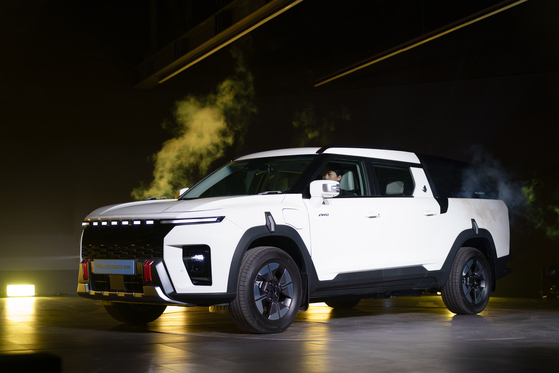Thirty years ago, the Ssangyong Musso shook the Korean SUV market with engines and technology from Mercedes-Benz. KG Mobility hopes to emulate that success with its new Musso EV, this time with BYD batteries. KG Mobility unveiled its first electric pickup truck, the Musso EV, on Wednesday, bringing back the moniker from its predecessor, SsangYong Motor. First released in 1993, the Musso is known to have started the luxury SUV market in Korea, as well as the sports utility pickup trend with the pickup version, the Musso Sport. The automaker’s chairman, Kwak Jae-sun, said the Musso EV is the “first new vehicle of KG Mobility” that he approved after his company, KG Group, acquired SsangYong Motor in 2022 and changed the automaker’s name to KG Mobility. “I was also the one who brought back the Musso moniker,” Kwak said during Wednesday’s launch event held at KG Mobility’s headquarters and plant in Pyeongtaek, Gyeonggi. Going forward, KG Mobility will use “Musso” as a name that covers the automaker’s pickup truck line, renaming the existing Rexton Sport and Rexton Sport Khan pickup to the Musso Sport and Musso Khan, respectively. While the Musso EV features a front facia more reminiscent of the automaker’s other SUVs on the market, the Torres and Actyon, KG Mobility claims that it is inspired by SsangYong’s Musso. The new EV pickup, at 5,160 millimeters (203 inches) in length, is smaller than a Ford Ranger but is slightly longer than Ford’s smallest pickup truck, the Maverick. It is also shorter than the double-cab version of the Kia Tasman at 5,410 millimeters. The automaker was keen to compare the Musso head-on with the Tasman. “The most compelling advantage of the Musso compared to (the Tasman) is that it is economical,” KG Mobility’s head of domestic sales and marketing, Park Kyung-joon, said, as the automaker presented slides directly comparing the models. The company said the Musso’s faster acceleration response time, better weight distribution and better noise control thanks to its EV architecture made it the better choice over Kia’s gasoline-powered Tasman. “So why pay more?” Park said. The sales chief also emphasized that the Musso EV had two more degrees of sliding and reclining in the rear seats compared to the Tasman. The rear seats, indeed, provided adequately comfortable seating for adults. The EV also comes with new versions of the infotainment system, which previously received criticism for slow response times and convoluted menus. The Musso EV is equipped with BYD’s 80.6 kilowatt-hour Blade lithium iron phosphate battery, which allows the front-wheel drive version to achieve 400 kilometers (248 miles) of range, with energy consumption of 4.2 kilometers per kilowatt. The front-wheel drive version, which hits the market this month, features a 152 kilowatt-hour motor producing 207 metric horsepower (204 mechanical horsepower), while the four-wheel drive version, set to be released in May, offers 413 metric horsepower. The two-wheel drive model starts at 48 million won ($33,000) and is expected to receive around 6.52 million won in a government subsidy on top of local government subsidies. The automaker estimated that it would receive 1.86 million won in local government subsidies in Seoul. Wednesday’s press conference was also attended by staff from FinDreams, BYD’s battery subsidiary, as the automaker is continuing its collaboration with the Chinese firm in the development of the upcoming Torres Hybrid in its continuing efforts to turn a new leaf. “KG Mobility has a 71-year history as a carmaker, but honestly, the company wasn’t able to release that many (good) vehicles due to the twists and turns it had to go through,” the chairman said. “While our company may be small, we will be catching up in the market with unprecedented speed.” BY CHO YONG-JUN ((email protected))

